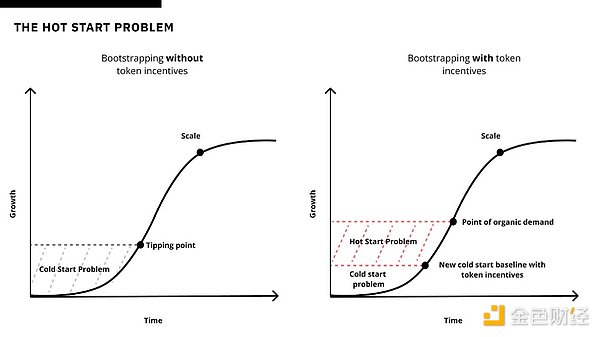Author: Mason Nystrom, former Variant Fund Venture Partner; Translation: Golden Finance xiaozou
Tokens (or token promises) have proven to be effective in alleviating the cold start problem when combined with new and innovative products. However, while speculation brings the benefits of network activity, it also comes with the challenges of short-term liquidity and inorganic users.
Markets and networks that choose to issue tokens at the outset (or before sufficient organic demand is established) must form PMF (product market fit) in a shorter period of time, otherwise they will use up the tokenized bullets in their growth guns.
My friend and investor Tina calls this the "hot start problem", where the existence of a token limits the window of time in which a startup can form PMF and gain enough organic traction to retain users/liquidity even as token rewards decrease.

Applications launched using a points system will also encounter a hot start problem because users now have some kind of expectation for the token.
I really like the term "hot start problem" because the core difference in the crypto world compared to web2 is the ability to use tokens (financial incentives) as a tool to launch new networks.
This strategy has proven to be effective, especially for DeFi protocols like MakerDAO, DyDx, Lido, GMX, etc. The token launch method has also proven to be effective for other crypto networks, from DePINs (such as Helium) to infrastructure (such as L1) and certain middleware (such as oracles). However, networks that respond to the hot start problem by flash-scaling their tokens face several trade-offs, including ambiguity in organic traction/PMF, premature consumption of growth guns, and greater friction in completing operational tasks due to DAO governance (e.g., fundraising, governance decisions, etc.).
1, Choose a Hot Start
Compared to the cold start problem, there are two situations where people prefer the hot start problem:
· Startups competing in red ocean markets (markets with high competition and clear demand)
· Products and networks with passive supply
(1) Red Ocean Markets
The core disadvantage of the hot start problem is the inability to determine organic demand, but this problem is mitigated when building a category with strong product-market fit. It is in situations like these that latecomers have the potential to successfully compete with those who entered the market earlier by issuing tokens early. The DeFi space is full of examples of latecomers overcoming the hot start problem by effectively using tokens to launch new protocols. While Bitmex and Perpetual Protocol were the first centralized and decentralized exchanges to offer perp (perpetual contracts) trading, respectively, latecomers such as GMX and dYdX have used tokens to quickly increase liquidity and become leaders in the perp category. Compared to first movers such as Compound, emerging DeFi protocols in the lending space such as Morpho and Spark have successfully achieved billions of dollars in TVL, although first mover Aave (formerly ETHlend) still dominates. Today, there are clear signs of demand for emerging protocols, and tokens (and points) are the default choice for liquidity launch strategies. For example, liquidity staking protocols actively use points and tokens in order to increase liquidity in a highly competitive market.
Elsewhere in the consumer crypto space, Blur demonstrated a red ocean market competition strategy, with its market points system and token issuance making Blur the dominant Ethereum NFT trading venue by trading volume.
(2) Passive vs. Active Supply-Side Participation
The hot start problem of passive supply networks is easier to overcome than that of active supply networks. Looking at the history of token economics, we can find that tokens are useful when bootstrapping passive supply networks - staking, providing liquidity, listing assets (e.g. NFTs), or set-it and forget-it hardware (e.g. DePIN).
In contrast, although tokens have also successfully launched active supply networks, such as Axie, Braintrust, Prime, YGG, and Stepn, the premature appearance of tokens often makes it difficult to find true product-market fit. Therefore, the hot start problem is more challenging in active supply networks than in passive supply networks.
The lesson here is not that tokens are ineffective in active networks, but that when applications and markets introduce token incentives for active networks (usage, gameplay, services, etc.), they must take additional measures to ensure that token rewards are driven in the direction of organic usage and drive growth in important metrics such as stickiness and retention. For example, the data annotation network Sapien gamifies the annotation task and allows users to earn more points by staking points. In this case, passive staking when performing certain actions has the potential to play a loss aversion role, ensuring that participants submit higher quality data labels.
2, Speculation: Feature vs Bug
Speculation is a double-edged sword. If it is integrated into the product life cycle too early, it may become a bug, but if it can be used strategically, it can also become a powerful feature and growth tool to attract user attention.
Startups that launch tokens before gaining organic traction choose to deal with the hot start problem. They accept the pros and cons of using tokens as an external incentive to attract user attention while betting on their ability to find or create organic utility for their products amidst the increasing speculative noise.
 Weatherly
Weatherly





